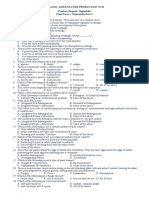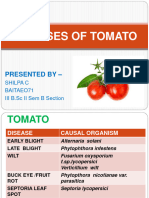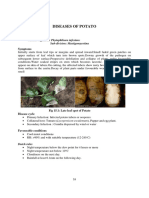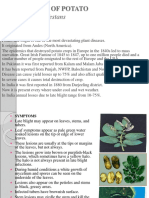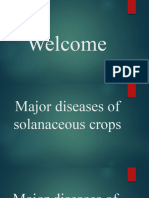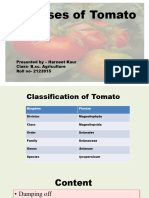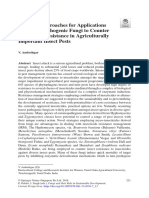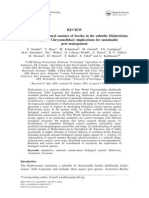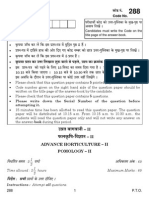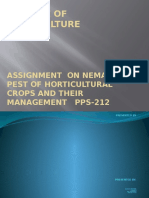Professional Documents
Culture Documents
Cercospora Moricola Peridiospora Mori Phyllactinia Corylea Alternaria Alternata Pseudomonas Syringae Pv. Mori
Uploaded by
கமல்ராஜ் இளநிலை வேளாண்மை0 ratings0% found this document useful (0 votes)
101 views27 pagesThis document lists various diseases that affect mulberry plants and their causal organisms. It provides details on symptoms, favorable conditions, and management strategies for 7 major diseases: 1) Leaf spot caused by Cercospora moricola, 2) Leaf rust caused by Peridiospora mori, 3) Powdery mildew caused by Phyllactinia corylea, 4) Leaf blight caused by Alternaria alternata, 5) Bacterial leaf blight caused by Pseudomonas syringae pv. mori, 6) Sooty mould caused by Capnodium species, and 7) Root knot nematode caused by Meloidogyne incognita. For each disease
Original Description:
Power point presentation
Original Title
Mulberry
Copyright
© © All Rights Reserved
Available Formats
PPTX, PDF, TXT or read online from Scribd
Share this document
Did you find this document useful?
Is this content inappropriate?
Report this DocumentThis document lists various diseases that affect mulberry plants and their causal organisms. It provides details on symptoms, favorable conditions, and management strategies for 7 major diseases: 1) Leaf spot caused by Cercospora moricola, 2) Leaf rust caused by Peridiospora mori, 3) Powdery mildew caused by Phyllactinia corylea, 4) Leaf blight caused by Alternaria alternata, 5) Bacterial leaf blight caused by Pseudomonas syringae pv. mori, 6) Sooty mould caused by Capnodium species, and 7) Root knot nematode caused by Meloidogyne incognita. For each disease
Copyright:
© All Rights Reserved
Available Formats
Download as PPTX, PDF, TXT or read online from Scribd
0 ratings0% found this document useful (0 votes)
101 views27 pagesCercospora Moricola Peridiospora Mori Phyllactinia Corylea Alternaria Alternata Pseudomonas Syringae Pv. Mori
Uploaded by
கமல்ராஜ் இளநிலை வேளாண்மைThis document lists various diseases that affect mulberry plants and their causal organisms. It provides details on symptoms, favorable conditions, and management strategies for 7 major diseases: 1) Leaf spot caused by Cercospora moricola, 2) Leaf rust caused by Peridiospora mori, 3) Powdery mildew caused by Phyllactinia corylea, 4) Leaf blight caused by Alternaria alternata, 5) Bacterial leaf blight caused by Pseudomonas syringae pv. mori, 6) Sooty mould caused by Capnodium species, and 7) Root knot nematode caused by Meloidogyne incognita. For each disease
Copyright:
© All Rights Reserved
Available Formats
Download as PPTX, PDF, TXT or read online from Scribd
You are on page 1of 27
Disease Causal organism
Leaf Spot Cercospora moricola
Leaf Rust Peridiospora mori
Powdery Mildew Phyllactinia corylea
Leaf Blight Alternaria alternata
Bacterial Leaf Pseudomonas syringae pv. mori
Blight/Spot
Sooty Mould Capnodium species
Root knot Nematode Meloidogyne incognita
Leaf spot- Cercospora moricola
Symptoms
Prevalent during rainy season followed by winter .
Disease starts progressing 35-40 days after pruning
(DAP) / Leaf harvesting and becomes severe on the
70th DAP
Brownish necrotic , irregular spots appear on the leaf
surface
Circular light brown spots appear on both sides of the
leaves
Highly infected leaves defoliate prematurely
Leaves become yellow and wither off as disease
become severe
Temperature of 24- 26⁰C and 70- 80% relative
humidity are most congenial for the disease
development
Disease is air borne spreading by conidia primarily
through rain droplets
Spraying of 0.2 % Bavistin solution on the leaves
Safe period : 5 days
Symptoms
Disease is more prevalent during winter and rainy
season
45-50 DAP become severe on 70th DAP
Mature leaves are more prone to the disease
Several small pin head shaped brown pustules appear
on the lower surface of mature leaves
Reddish brown spot appear on the upper surface of the
infected leaves
Severely infected leaves turn yellowish and margin of
the leaves become dry
Dispersingby air borne uredospores through
water droplets and wind current
Temperatureof 22-26⁰C and high relative humidity
above 70% are favourable for the disease
development
Follow wider spacing of plantation or paired row
system
Avoid delayed leaf harvest
Spraying 0.2% kavach on the leaves
Safe period :5 days
Symptoms:
Disease is prevalent during winter and rainy
seasons and progresses 40th DAP leaf harvest
becoming severe on 70th DAP
White powdery patches appear on the lower
surface of leaf which is gradually increased and
cover whole leaf surface
Affected leaves turn yellowish and defoliate
prematurely
Disease spread by air borne conidia primarily
through wind
Temperature of 24-28⁰C and high relative
humidity( 75-80%) are responsible for infection
and disease development
Follow wider spacing of plantation
Spraying of 0.2 % Bavistin on the lower surface of
the leaves
Symptoms
Disease starts progressing 45th DAP becoming
severe on 70th DAP and is prevalent during
summer and rainy seasons
Browning\ blackening of leaves starting either
from the leaf tip or edges of leaf lamina in the
form of isolated irregular brown coloured patches
In severe cases disease spreads the entire leaf
surface is affected resulting in fall of leaves
The disease is air borne dispersing by conidia
through water droplets and wind current
Temperature of 25 -30⁰C and relative humidity of
40-60% are favourable for the outbreak of fungal
blights
Remove the infested leaves ,collect in a polythene
bag and destroy by burning
Spray 0.2% Indofil M.45
Symptoms
Thick black coating developed on the upper
surface of the leaves
Mycelium superficial and lives on the sugary
secretion of the sucking pests like hoppers, jassids,
aphids and mealy bugs.
Presence of adult white flies or their nymph in the
garden which suck the sap from tender leaves
resulting inchlorosis and leaf curl. The highly
infected leaves fall off from the shoot.
Photosynthetic activity of plant is reduced
Pathogen Fungus produces 5 types of conidia such
as
1. Torula - Yeast like fungus composed of chains
of rounded cells, growing on dead vegetation
2. Trichothecium – 2 celled colourless pink spore
bilaterally, symmetrical youngest on bottom
3. Coniothecium
4. Brachysporium
5. Ascospores from Pseudothecia
Honeydew excreted by sucking insects serves as a
balanced growth medium for fungi.
Insect honeydews contain sugars, amino acids,
proteins, minerals, and vitamins all are required for
growth of the fungus.
Biological control: Release of 500 pairs
of Brumoides suturalis /acre suppresses the
population of whitefly population.
Mechanical control: Installation of yellow
coloured sticky traps @ 60 traps (2ft x 1 ft)/acre
reduces the white fly infestation.
Chemical control: Spray of insecticides such as
0.1% Dimethoate, 0.1% Dichlorvos or 1% Neem
oil azadirachtin 1500ppm) is recommended.
Two weeks (14 days) for both pesticides and
Indofil.
Symptoms
Disease is prevalent during rainy and winter
seasons and starts progresssing 35th DAP
becoming severe on 70th DAP
Numerous blackish brown irregular water soaked
patches appear on the leaves resulting in curling
and rotting of leaves
High temperature 28-30⁰C and high humidity
more than 80% are favourable for the disease
development
Disease is air and soil borne.
Soil primary source of infection
Secondary infection though irrigation and
cultivation practices
Remove the infested leaves ,collect in a polythene
bag and destroy by burning
Follow wider spacing of plantation
Spray 0.2% streptomycin solution
Symptoms
It is one of the major diseases limiting crop
production throughout the world
It can occur any time of the year mainly in sandy
soils low in organic matter
Infected plants become weak and predisposed to
other diseases while severely infected plants
ultimately die
Stunted growth
Poor and delayed sprouting
Symptoms
Reduced leaf size and yield
Formation of gall/knots on roots
Retarded root growth
Necrotic lesions on the root surfaces and death of
active rootlets
Reduced leaf size and yield
Poor and delayed sprouting
Disease spreads primarily though contaminated
soil ,farm implements and run off irrigation
Temperature 27-30⁰C ,soil moisture of less than
40%
Apply neem oil cake @ 800 kg/acre /yr in 4 split
doses during intercultural operation .
1. White root rot – Resellinia necatrix
2. Violet root rot – Helicobasidium mompa
3. Stem canker – Botryodiplodia theobromae
4. Stem rot - Polyporus hispidus
5. Collar rot - Phoma mororum
6. Stem blight –Phoma exigue
7. Bud blight – Fusarium lateritium
You might also like
- Disease of SorghumDocument29 pagesDisease of SorghumVikas BhardwajNo ratings yet
- Produce Organic Vegetables Summative 3 Final TermDocument1 pageProduce Organic Vegetables Summative 3 Final TermRocky B AcsonNo ratings yet
- Mulberry DiseasesDocument9 pagesMulberry DiseasesSharath.H sharuNo ratings yet
- Major Diseases of Horticultural Crops and This ManagementDocument61 pagesMajor Diseases of Horticultural Crops and This ManagementAnshul SharmaNo ratings yet
- Lecture 02 - Diseases of Mango (2 Lectures) : SymptomsDocument7 pagesLecture 02 - Diseases of Mango (2 Lectures) : SymptomsSanu KumarNo ratings yet
- Diseases of MangoDocument5 pagesDiseases of MangoAkash RoyNo ratings yet
- Management of Diseases of Important Agriculture Crops of Tamil NaduDocument43 pagesManagement of Diseases of Important Agriculture Crops of Tamil NaduVishnuvardhan RavichandranNo ratings yet
- Black Pepper - Fungal DiseasesDocument77 pagesBlack Pepper - Fungal DiseasesAnju ChalbhagathNo ratings yet
- Bacterial DiseasesDocument38 pagesBacterial Diseasesrenz jNo ratings yet
- Major Diseases of MangoDocument32 pagesMajor Diseases of MangoMahad Ahmed HilowleNo ratings yet
- Disease of ChilliDocument8 pagesDisease of ChilliSourabh PatilNo ratings yet
- Lecture 08 - Diseases of Chilli:: Pythium Aphanidermatum SymptomsDocument8 pagesLecture 08 - Diseases of Chilli:: Pythium Aphanidermatum SymptomsIll DuceNo ratings yet
- Boli Cu Poze Floarea SoareluiDocument10 pagesBoli Cu Poze Floarea SoareluiAndrea HernandezNo ratings yet
- Ipm Guava Revised Sept2011Document21 pagesIpm Guava Revised Sept2011pegasus86843No ratings yet
- Rice DiseaseDocument7 pagesRice DiseaseRudal ThakurNo ratings yet
- Lec 07Document14 pagesLec 07HubertNo ratings yet
- Lec 13Document21 pagesLec 13Subhradeep GhoshNo ratings yet
- Mango: Diseases and Symptoms: Powdery MildewDocument8 pagesMango: Diseases and Symptoms: Powdery MildewGlory May AntonioNo ratings yet
- Diseases of PeaDocument6 pagesDiseases of Peawodab95256No ratings yet
- Faculty of Agricultural Sciences and Allied Industries Diseases of Field&Horticultural Crops& Management 1 PPA - 312Document8 pagesFaculty of Agricultural Sciences and Allied Industries Diseases of Field&Horticultural Crops& Management 1 PPA - 312Aalok MishraNo ratings yet
- Field Problems of Vegetable CropsDocument81 pagesField Problems of Vegetable CropsAnuragBhatnagar100% (1)
- PP-202 Week 6Document5 pagesPP-202 Week 6Yasir IftikharNo ratings yet
- Banana Disease 2 PDFDocument4 pagesBanana Disease 2 PDFAlimohammad YavariNo ratings yet
- Diseases of PotatoDocument8 pagesDiseases of PotatoAkash RoyNo ratings yet
- Lecture 05 - Diseases of Pomegranate and PapayaDocument5 pagesLecture 05 - Diseases of Pomegranate and PapayaDirZeu AycaNo ratings yet
- Diseases of PotatoDocument8 pagesDiseases of PotatoAkash RoyNo ratings yet
- PAT 202 Manual - 2009-10Document138 pagesPAT 202 Manual - 2009-10Ananda PreethiNo ratings yet
- Diseasesoftomatonew 200728083816Document35 pagesDiseasesoftomatonew 200728083816dawit gNo ratings yet
- Lecture 07 - Disease of Apple (2 Lectures) : - Venturia Inaequalis SymptomsDocument8 pagesLecture 07 - Disease of Apple (2 Lectures) : - Venturia Inaequalis SymptomsAMBIKA BHANDARINo ratings yet
- Tomato DiseaeseDocument11 pagesTomato DiseaeseHassenNo ratings yet
- Lecture 03 - Diseases of Banana (2 Lectures) : Panama DiseaseDocument7 pagesLecture 03 - Diseases of Banana (2 Lectures) : Panama DiseaseSanu KumarNo ratings yet
- Major Diseases of Leguminous CropsDocument33 pagesMajor Diseases of Leguminous CropsAnup HamalNo ratings yet
- Diseases of PotatoDocument5 pagesDiseases of Potatoyakubpashaj7No ratings yet
- Apple: Diseases and SymptomsDocument5 pagesApple: Diseases and SymptomsAyshee BiswasNo ratings yet
- Diseases of CoconutDocument7 pagesDiseases of CoconutKA AngappanNo ratings yet
- Phytophthora Infestans: Late Blight of PotatoDocument9 pagesPhytophthora Infestans: Late Blight of PotatoHaider ALiNo ratings yet
- Major Diseases of Solanaceous CropsDocument52 pagesMajor Diseases of Solanaceous CropsAnup HamalNo ratings yet
- Lec22 Diseases of RoseDocument5 pagesLec22 Diseases of RoseAZIZRAHMANABUBAKARNo ratings yet
- Field Problems of Fruit CropsDocument80 pagesField Problems of Fruit CropsAnuragBhatnagar100% (2)
- Diseases of PomegranateDocument6 pagesDiseases of PomegranateMadhumithaNo ratings yet
- Majordiseasesofchilli 120424055536 Phpapp01Document22 pagesMajordiseasesofchilli 120424055536 Phpapp01Subbu YadavNo ratings yet
- Bacterial Leaf Spot and TipburnDocument4 pagesBacterial Leaf Spot and TipburnAlvin WatinNo ratings yet
- Enfermedades Foliares en MaizDocument26 pagesEnfermedades Foliares en MaizgegarborNo ratings yet
- Black Rot of Cole Crops: Xanthomonas Campestris)Document18 pagesBlack Rot of Cole Crops: Xanthomonas Campestris)Shahin Rahman 112700gmail.comNo ratings yet
- Disease of Horticultural Crops Their ManagementDocument172 pagesDisease of Horticultural Crops Their ManagementVijay JaybhayeNo ratings yet
- Corn DiseasesDocument46 pagesCorn DiseasesMandre DynaNo ratings yet
- An Assignment ON Diseases of Tomato and Their ManagementDocument26 pagesAn Assignment ON Diseases of Tomato and Their ManagementMounika pylaNo ratings yet
- Diseases of Horticultural Crops and Their ManagementDocument90 pagesDiseases of Horticultural Crops and Their Managementnormanwillow67% (3)
- Disease in FruitsDocument177 pagesDisease in FruitsJigar PatelNo ratings yet
- Major Diseases and Their Casual Agents of Major Ornamental Plants With Major Control MeasuresDocument11 pagesMajor Diseases and Their Casual Agents of Major Ornamental Plants With Major Control MeasuresAgriculture ForumNo ratings yet
- Mango Diseases and Their ManagementDocument9 pagesMango Diseases and Their ManagementShakilurRehman PrinceNo ratings yet
- PP-202 Plant VirologyDocument43 pagesPP-202 Plant VirologyMahnoorIshtiaqNo ratings yet
- Cotton Diseases atDocument5 pagesCotton Diseases atwodab95256No ratings yet
- Lec07 PDFDocument24 pagesLec07 PDFSayan royNo ratings yet
- Presentation (Tomato)Document33 pagesPresentation (Tomato)Sukhbir kaurNo ratings yet
- Lec 20Document4 pagesLec 20dawit gNo ratings yet
- Mango 2Document20 pagesMango 2Shreya KumariNo ratings yet
- Diseases of MangoDocument21 pagesDiseases of MangoYasir Mueen GishkoriNo ratings yet
- IPM of Rose DiseasesDocument57 pagesIPM of Rose DiseasesGheorghe IuroaeaNo ratings yet
- Powdery Mildew: - Oidium Caricae SymptomsDocument3 pagesPowdery Mildew: - Oidium Caricae SymptomsSanu KumarNo ratings yet
- Lista de Plagas Cuarentenarias 2016Document16 pagesLista de Plagas Cuarentenarias 2016CHRISTIAN GONZALEZNo ratings yet
- MCQ Class XII BiopesticidesDocument2 pagesMCQ Class XII Biopesticidessakthi100% (1)
- EntomopathogenicDocument34 pagesEntomopathogenicEmilio Lecaros BustamanteNo ratings yet
- Sigatoka Leaf SpotDocument13 pagesSigatoka Leaf SpotRakesh KumarNo ratings yet
- Biopesticides InfographicDocument1 pageBiopesticides InfographicBernadette L. CashNo ratings yet
- A Review of The Natural Enemies of Beetles in The Subtribe Diabroticina (Coleoptera: Chrysomelidae) : Implications For Sustainable Pest ManagementDocument65 pagesA Review of The Natural Enemies of Beetles in The Subtribe Diabroticina (Coleoptera: Chrysomelidae) : Implications For Sustainable Pest ManagementBlue Dasher FarmNo ratings yet
- PATH-365 Objective @agrounderDocument13 pagesPATH-365 Objective @agrounderNalini PathakeNo ratings yet
- Integrated Disease ManagementDocument4 pagesIntegrated Disease ManagementShah PankajNo ratings yet
- Tomato: Crop Info-SheetDocument4 pagesTomato: Crop Info-SheetCarlos gongoraNo ratings yet
- Form A AnnexureDocument1 pageForm A Annexureab npcNo ratings yet
- International Journal of Entomological ResearchDocument5 pagesInternational Journal of Entomological ResearchsarfarazNo ratings yet
- 288 Advance Horticulture II Pomology IIDocument5 pages288 Advance Horticulture II Pomology IISahil ChaudharyNo ratings yet
- Major Uses of PesticidesDocument49 pagesMajor Uses of Pesticidesavithi ajithkumarNo ratings yet
- Integrated Pest ManagementDocument24 pagesIntegrated Pest ManagementYoga PradanaNo ratings yet
- Early Blight: World Vegetable CenterDocument2 pagesEarly Blight: World Vegetable CenterPreet MaanNo ratings yet
- Mango MalformationDocument16 pagesMango Malformationsurajpratap1412No ratings yet
- Crop WiseDocument8 pagesCrop WiseAvinash_DLNo ratings yet
- Peanut.10.4.Diseases and InsectsDocument31 pagesPeanut.10.4.Diseases and InsectsFilipe FariasNo ratings yet
- KEANEKARAGAMAN Trips (Thysanoptera) PADA BERBAGAI JENIS TANAMAN SAYURAN DI JAWA BARAT DAN JAWA TENGAH HIDA NOER ANUGRAWATIDocument40 pagesKEANEKARAGAMAN Trips (Thysanoptera) PADA BERBAGAI JENIS TANAMAN SAYURAN DI JAWA BARAT DAN JAWA TENGAH HIDA NOER ANUGRAWATITsamara Khansa AzzahraNo ratings yet
- Uji Antagonisme Jamur Patogen Fusarium Solani Penyebab Penyakit Layu Pada Tanaman Cabai Dengan Menggunakan Beauveria Bassiana Secara in VitroDocument10 pagesUji Antagonisme Jamur Patogen Fusarium Solani Penyebab Penyakit Layu Pada Tanaman Cabai Dengan Menggunakan Beauveria Bassiana Secara in VitroDyan PitalokaNo ratings yet
- Pythium Root Rot in Tobacco Float SystemsDocument3 pagesPythium Root Rot in Tobacco Float SystemsSadao MatsumotoNo ratings yet
- Planthopper - IRRI Rice Knowledge BankDocument3 pagesPlanthopper - IRRI Rice Knowledge BankVijay Kumar NandagiriNo ratings yet
- Commercial Quality of Seed PotatoesDocument112 pagesCommercial Quality of Seed PotatoesPedro Daniel LeivaNo ratings yet
- Ostrinia Furnacalis (Lepidoptera:Pyralidae), Dan Hubungannya Dengan KehilanganDocument3 pagesOstrinia Furnacalis (Lepidoptera:Pyralidae), Dan Hubungannya Dengan Kehilangandianiile02No ratings yet
- Major Potato Diseases, Insects, and NematodesDocument61 pagesMajor Potato Diseases, Insects, and NematodesrazagujjarNo ratings yet
- Biologija I Epidemiologija Mikrogljive Venturia in PDFDocument8 pagesBiologija I Epidemiologija Mikrogljive Venturia in PDFPetar StojanovicNo ratings yet
- Fungicide FormulationDocument1 pageFungicide FormulationQasim JanNo ratings yet
- Applied Mycology and Plant Pathology: M. Sc. BOTANY (MSCBOT-12/13/16) Second Year, Examination, 2017Document6 pagesApplied Mycology and Plant Pathology: M. Sc. BOTANY (MSCBOT-12/13/16) Second Year, Examination, 2017satish vermaNo ratings yet
- College of Horticulture C.A.U: Assignment On Nematode Pest of Horticultural Crops and Their Management Pps-212Document24 pagesCollege of Horticulture C.A.U: Assignment On Nematode Pest of Horticultural Crops and Their Management Pps-212Cheng Wong LeeNo ratings yet

